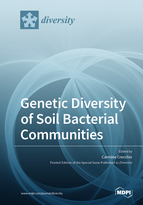Genetic Diversity of Soil Bacterial Communities
A special issue of Diversity (ISSN 1424-2818). This special issue belongs to the section "Microbial Diversity and Culture Collections".
Deadline for manuscript submissions: closed (30 June 2020) | Viewed by 20491
Special Issue Editor
Interests: microbial ecology; soil microbial diversity; soil fertility; metagenomics of soil bacteria communities; plant-growth-promoting bacteria; biofertilizers
Special Issues, Collections and Topics in MDPI journals
Special Issue Information
Dear Colleagues,
Soil is an important natural resource and has a key role in the biosphere, as most of the carbon and nutrient fluxes occur in the top 10 cm of the soil profile; it is a species-rich habitat that provides support for plant growth and health and, consequently, affects human activities. Although broadly homogeneous in the landscape, soil is extremely heterogeneous on a microbial scale. In fact, soil supports taxonomic and physiologic microbial diversity, which is regarded as more extensive than that of any other group of organisms and considered vitally important to the maintenance and sustainability of the biosphere.
Looking within the “black box”, as soil has been regarded in the last decades; overcoming its inaccessibility; and understanding its microbial composition and functioning, are challenges for scientists. In particular, if it is important to investigate the genetic diversity of microbial populations, it is also fundamental to understand the link between the major functions of microbial biomass and its species composition.
As Guest Editor for a Special Issue entitled "Genetic Diversity of Soil Bacterial Communities" to be published in the journal Diversity, I invite you to submit research articles, review articles, or short communications. Papers should address all the relevant and unclear aspects of the composition and functioning of bacterial communities, in agricultural and natural soil, in field trials, in laboratory-scale experiments, in rich or marginal soils, at different latitudes, and under different types of management.
Dr. Carmine Crecchio
Guest Editor
Manuscript Submission Information
Manuscripts should be submitted online at www.mdpi.com by registering and logging in to this website. Once you are registered, click here to go to the submission form. Manuscripts can be submitted until the deadline. All submissions that pass pre-check are peer-reviewed. Accepted papers will be published continuously in the journal (as soon as accepted) and will be listed together on the special issue website. Research articles, review articles as well as short communications are invited. For planned papers, a title and short abstract (about 100 words) can be sent to the Editorial Office for announcement on this website.
Submitted manuscripts should not have been published previously, nor be under consideration for publication elsewhere (except conference proceedings papers). All manuscripts are thoroughly refereed through a single-blind peer-review process. A guide for authors and other relevant information for submission of manuscripts is available on the Instructions for Authors page. Diversity is an international peer-reviewed open access monthly journal published by MDPI.
Please visit the Instructions for Authors page before submitting a manuscript. The Article Processing Charge (APC) for publication in this open access journal is 2600 CHF (Swiss Francs). Submitted papers should be well formatted and use good English. Authors may use MDPI's English editing service prior to publication or during author revisions.
Keywords
- Soil bacterial diversity
- Soil fertility
- Metagenomics of soil bacteria communities






